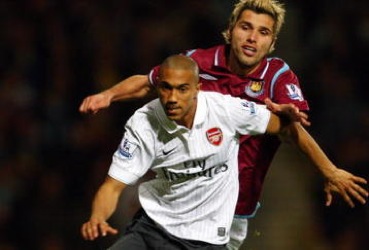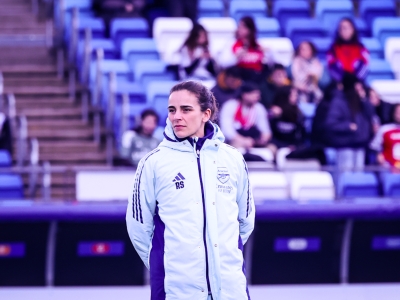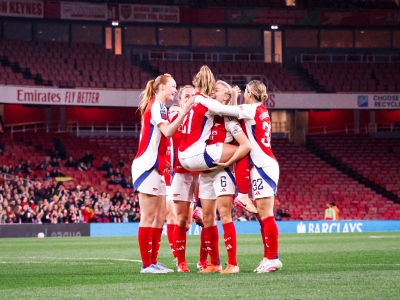Is our apparent attacking “quality” actually being masked by sheer numbers, and does this lead to a lack of balance which is causing our lack of defensive shape?
We hear a great deal about Arsenal’s supposed attacking prowess – our ability to swamp supposed lesser teams with pace and movement. This is supported by our excellent “goals for” record thus far this season. However, despite our quality, to what extent is this down to sheer weight of numbers as opposed to attacking nous? Our full-backs bomb-on, one of our centre-backs occasionally becomes an additional attacker, while Song has also been known to arrive into the box to supplement an attack. This functions well against mid-table and below teams, and can be a joy to behold (Blackburn at home, Wolves and Everton away).
However, we’ve also seen a fair few occasions of late (and not just against the Manchester Uniteds and Chelseas of this world) whereby Arsenal are caught on the hop after losing the ball in such positions, and a goal is conceded on the counter attack from a previously positive position.
Our current style of play attempts to dominate possession and wear teams down. The current Wenger view appears to be that our movement and numbers will be enough to force openings against massed ranks, and that if a goal does not come early our opponents will tire due to the aforementioned domination of possession and increased numbers in attack. However, it was not always thus, and I would argue this current way of playing – given the relatively callow age of our young charges and the linked lack of experience – is actually making life far harder for ourselves.
The much touted “lack of a plan B” is not the problem here – we are able to vary our play; with Diaby in the team we have borne witness this season to something approaching a defensive line-breaking run or two and even the odd floated ball over the top for one of our diddymen to run onto alongside the standard tippy-tappy we’ve come to regard as the norm; when Robin van Persie is fit the options up front allow for a wide variety of attacking approaches due to his ability to adapt to the role early in the season. In fact, the problem is one of the use of space and resources. The parallels with the world of work in the current climate are many – what we should be able to achieve with the current playing staff is more with less. By which I mean continue to enact a high-tempo attacking style but without the attendant risks attached that we currently impose on ourselves.
Efficiency is not a byword that you can associate with the current Arsenal team. We may have the highest shots-to-goals ratio in the league at the time of writing (and thankfully so), but we also dominate the possession stats, passing stats, and – following the defeat at Stamford Bridge this shows this up for the folly that it is – are high in the corners-won (and probably corners-hit-frontman) stats. Other teams are fully capable of scoring goals by attacking teams with not seven, eight or nine men, but with three to five, leaving themselves far less exposed when the ball is lost. Whereas we seem to have a situation over the last 14 months that wherever on the pitch Gael Clichy loses the ball there is a clear run with a goal at the end of it.
Early in the season, the shift to 4-3-3/4-5-1 was lauded as it played to the strengths of a number of our players. However, when taken alongside the attacking intent of our full-backs, this is increasingly exposed – as shown by the number of away clean sheets this season. Arshavin; Nasri; Rosicky; Walcott (!?): when playing wide, how much assistance is their full back provided? How often have you seen Clichy/Sagna lose the ball high up the pitch and then see the winger in front of him track the man back? I have the odd recollection, but it does not occur nearly often enough. The defence is more likely to shuffle across to fill the gaps which leaves the team open to a quick switch of play by our opponents.
We have the players to dominate sides, and provide sufficient attacking width while still maintaining something approaching a back four. If Arshavin, Rosicky, Fabregas, Diaby plus one other (either up front or in midfield) aren’t able to open up a defence without constantly requiring the width provided by our fullbacks, or an additional body such as Song or Vermaelen pushing through centrally, then there is something seriously malfunctioning when it comes to our shape as I cannot think of another Premier League team that uses such a high portion of its resources for attacking purposes.
Unfortunately, we need only cast our minds back to last season when the shocking start to the campaign was arrested by a more sedate approach that saw our full-backs push forward less frequently, and a run of dull 0-0 draws ensued. What is it about this current Arsenal team that requires so many bodies in order to achieve the game’s fundamental aim?
When we were a primarily counter-attacking team this was not an issue as by its very nature a counter attack is against fewer players, and thus requires fewer to push forward. When we played possession football at Highbury (there are times we now miss the narrowness of the pitch despite the much vaunted extra space) with the likes of Bergkamp, Pires, Vieira and Henry in the team, we were able to dominate teams with lesser numbers, with the timing of the fullback runs more important than their mere existence. Now a young, callow team requires such runs due to a combination of the slower speed of our attacks, the attendant massed ranks of defenders, a larger space to cover (at least at home), the lack of a central Dennis Bergkamp-style player (though Cesc will approach that level in the coming years), and a seeming lack of confidence and/or ability to break through defences without committing large numbers of men forward. Football is a game of shape, and ours is one that currently is in need of revision.
The example of a midfield three of Fletcher, Scholes and Carrick tells us what we are missing unfortunately. I know not a single Arsenal fan that wasn’t confident going into the recent 3-1 reverse, seeing Manchester United as a team close to being there for the taking compared to previous years. The core reason they weren’t overcome wasn’t to do with a poor keeper, a lack of cover when being counter-attacked etc – they are all symptoms of the current issue – but Arsenal’s default shape affording no safety net to any player once a mistake is made. Yes, Nasri could have helped Clichy out better for the Almunia own goal – but it’s the very lack of support (or style of/training for that support) for the fullback as an endemic issue which requires addressing. The lack of responsibility taken by anyone to at least track Rooney (if not take him out!) when he was making that incredibly hard to read run for the second (you know, when someone runs in a perfectly straight line bisecting both the centre and penalty spots) was also worrying and a point which could be addressed via a leaner, more compact shape.
Shape and balance. These are to this current Arsenal team more important than a good first touch and the ability to reverse a strike across the keeper’s dive off the far post as they are issues that are not being addressed. If anyone can name a successful football team whose approach to shape is to mimic that of the “crack suicide squad” from Life of Brian, I would love to hear it. Sadly they at times resemble our forebears.
Continuing the parallel with necessitated approaches in the world of work, Arsene needs to learn how we can do more with less, thus freeing up our ability to maintain shape, balance and intelligently apply this to ensuring that the sorties forward enjoyed by each member of our back four is only applied at moments of lesser risk or maximum opportunity. By it becoming our default we are exposed unnecessarily to the risk of conceding. The fundamental education being “enjoyed” by our young team is in those respects flawed. Gael Clichy is a case-in-point – where our former left back learned his defensive trade over time due to being within a stricter structure, Gael has been left exposed by those in front of him and his decision-making has regressed due to the poor shape of the team around him – I fear for the lad’s development due to this and think that as a club we may actually be doing him a disservice.







